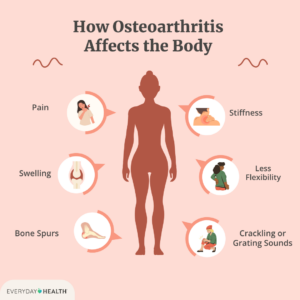Menopause is a natural part of ageing and can be understood as the end of a female’s reproductive years. During menopause, a woman’s body goes through numerous physiological and psychological changes. The prominent physiological symptom of menopause is a woman’s ovary terminating the release of eggs for fertilisation. This phase is also marked by a significant drop in the reproductive hormones that assist a woman’s reproductive cycle.
While a common notion exists among people that the effects of menopause are limited to reproductive function but studies over time have shown that menopausal and post-menopausal women may experience symptoms related to other health conditions as well. One among them is poor bone and joint health.
Osteoarthritis, a common kind of arthritis is often seen in postmenopausal women. Medical research has shown a correlation between menopause and declining joint health among menopausal women.
Let us read further to understand the connection between the two.
Estrogen: The missing key
Estrogen is a steroid-based hormone, typically known to assist the female reproductive cycle. It actively plays a role in stimulating ovaries to form egg follicles during the reproductive years of a female and also helps maintain the uterus’ function. However, what is not popularly known is the role of this hormone in sustaining cognitive, cardiovascular and even musculoskeletal health.
During menopause, a woman experiences significant decline in estrogen levels. The hormone has an anti-inflammatory function and following its decline, there can be increased levels of inflammation in the body including joints.
With decreasing estrogen levels, there are also changes in the bone density. The lowered bone density can make the bones of menopausal women more prone to fractures and inflammation. This can further increase joint discomfort.
In Osteoarthritis, there is a breakdown of cartilage between joints. This can be seen in joints of the shoulder, spine, knees and hips.
What it is to live with Osteoarthritis?
Menopausal or post-menopausal women living with this condition might experience symptoms like chronic lower back pain, stiffness around a joint, decreased range of motion around the joint and others. Sometimes, the joint might also appear different (unusual), especially in case of some deformity.
Certain factors can make menopausal women more prone to osteoarthritis than others. This includes obesity, bone deformity, nutritional deficiency, diabetes, injuries or falls, family history and other factors.
Treatment
Osteoarthritis is a degenerative condition with no definite cure for it. However, the symptoms can be managed with a customised treatment plan. The affected menopausal women might be advised to keep a healthy weight, eat a balanced diet, consume anti-inflammatory medications or seek physical therapy. This can help prevent the amplification of symptoms and their interference with day-to-day life.
If the joint damage is acute, then joint replacement surgery becomes a considerable choice for those affected.
Apart from seeing an orthopaedician, affected menopausal women might also seek help from an attending gynaecologist. In such cases, they might be put on hormonal replacement therapy which includes the intake of synthetic estrogen to restore the lost protective functions of the hormone.
Your Walk, Our Priority
Dr. Rohit Lamba is the Head of Department & Sr. Consultant of Bone, Joint Replacement & Orthopaedics at SHALBY Sanar International Hospitals, Gurugram.














